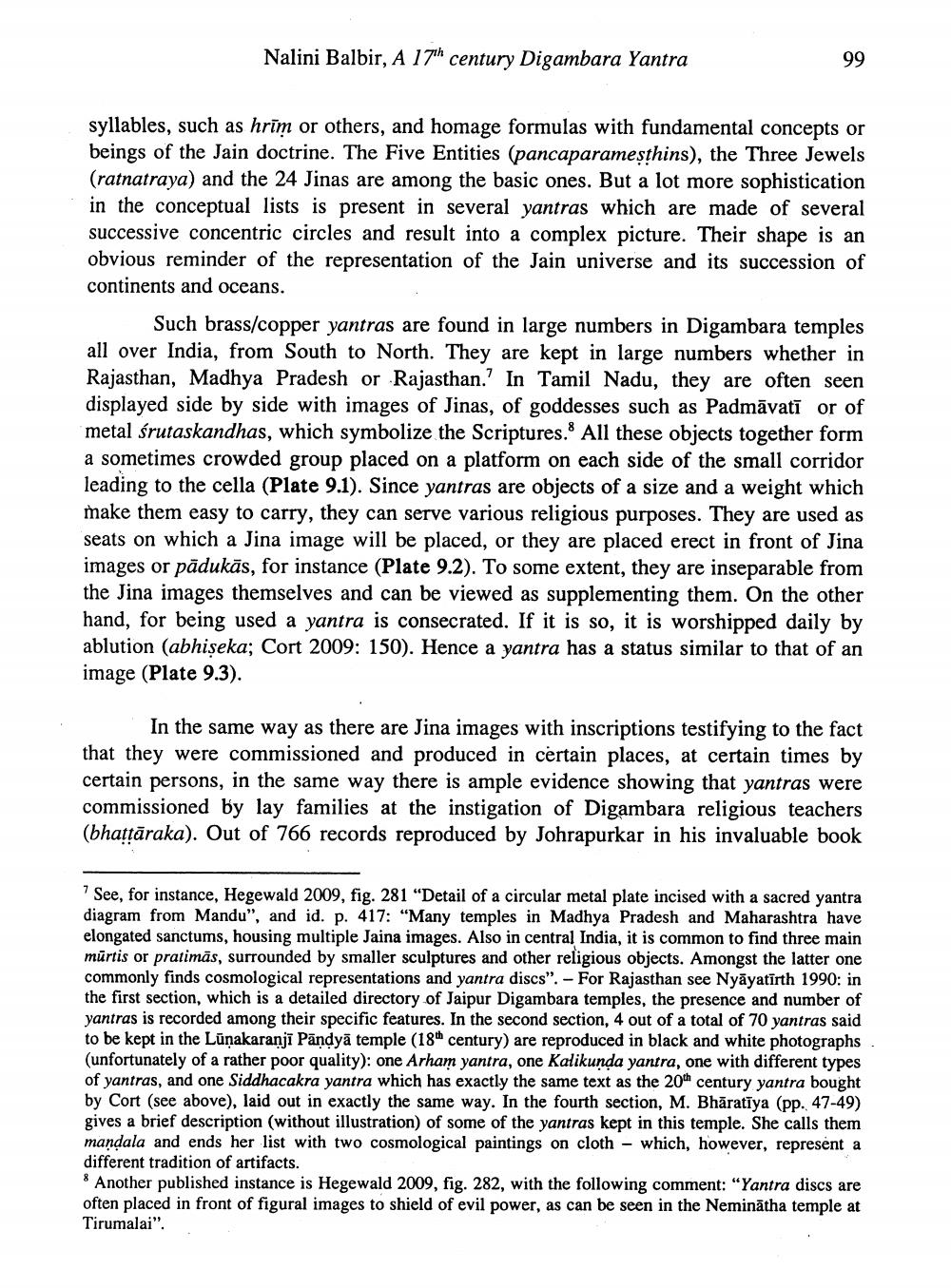________________
Nalini Balbir, A 17" century Digambara Yantra
99
syllables, such as hrim or others, and homage formulas with fundamental concepts or beings of the Jain doctrine. The Five Entities (pancaparamesthins), the Three Jewels (ratnatraya) and the 24 Jinas are among the basic ones. But a lot more sophistication in the conceptual lists is present in several yantras which are made of several successive concentric circles and result into a complex picture. Their shape is an obvious reminder of the representation of the Jain universe and its succession of continents and oceans.
Such brass/copper yantras are found in large numbers in Digambara temples all over India, from South to North. They are kept in large numbers whether in Rajasthan, Madhya Pradesh or Rajasthan.? In Tamil Nadu, they are often seen displayed side by side with images of Jinas, of goddesses such as Padmāvati or of metal śrutaskandhas, which symbolize the Scriptures. All these objects together form a sometimes crowded group placed on a platform on each side of the small corridor leading to the cella (Plate 9.1). Since yantras are objects of a size and a weight which make them easy to carry, they can serve various religious purposes. They are used as seats on which a Jina image will be placed, or they are placed erect in front of Jina images or pădukās, for instance (Plate 9.2). To some extent, they are inseparable from the Jina images themselves and can be viewed as supplementing them. On the other hand, for being used a yantra is consecrated. If it is so, it is worshipped daily by ablution (abhișeka; Cort 2009: 150). Hence a yantra has a status similar to that of an image (Plate 9.3).
In the same way as there are Jina images with inscriptions testifying to the fact that they were commissioned and produced in certain places, at certain times by certain persons, in the same way there is ample evidence showing that yantras were commissioned by lay families at the instigation of Digambara religious teachers (bhattāraka). Out of 766 records reproduced by Johrapurkar in his invaluable book
See, for instance, Hegewald 2009, fig. 281 "Detail of a circular metal plate incised with a sacred yantra diagram from Mandu", and id. p. 417: “Many temples in Madhya Pradesh and Maharashtra have elongated sanctums, housing multiple Jaina images. Also in central India, it is common to find three main murtis or pratimas, surrounded by smaller sculptures and other religious objects. Amongst the latter one commonly finds cosmological representations and yantra discs". - For Rajasthan see Nyāyatīrth 1990: in the first section, which is a detailed directory of Jaipur Digambara temples, the presence and number of yantras is recorded among their specific features. In the second section, 4 out of a total of 70 yantras said to be kept in the Lūņakaranji Pandya temple (18th century) are reproduced in black and white photographs (unfortunately of a rather poor quality): one Arham yantra, one Kalikunda yantra, one with different types of yantras, and one Siddhacakra yantra which has exactly the same text as the 20th century yantra bought by Cort (see above), laid out in exactly the same way. In the fourth section, M. Bhāratīya (pp. 47-49) gives a brief description (without illustration) of some of the yantras kept in this temple. She calls them mandala and ends her list with two cosmological paintings on cloth - which, however, represent a different tradition of artifacts. * Another published instance is Hegewald 2009, fig. 282, with the following comment: "Yantra discs are often placed in front of figural images to shield of evil power, as can be seen in the Neminātha temple at Tirumalai".




